Omar L. Harris's Blog, page 2
October 26, 2024
Finding the Flow: The Key to Unlocking Peak Performance for Your Team

Leaders today are constantly challenged to do more with less—less time, fewer resources, and tighter deadlines. Amid this pressure, finding your own state of flow and helping your team members tap into theirs can transform your organization from a place of constant hustle to one of sustained, high-quality performance. But what exactly is flow, and how can leaders intentionally cultivate it both for themselves and their teams?

First introduced by psychologist Mihaly Csikszentmihalyi, flow is a state of complete immersion in an activity where time seems to disappear, and your focus is razor-sharp. When you’re in flow, everything aligns: your skills, the challenge in front of you, and the absence of distractions. It’s a powerful state because it drives productivity, creativity, and a sense of accomplishment. Leaders who can consistently enter this state are not only more effective in their work but can inspire the same level of commitment and engagement in their teams.
The journey to finding flow unfolds through several distinct stages, each building on the other to lead you into a state of complete immersion and optimal performance. The first stage is the struggle phase, which is often marked by frustration or difficulty as you grapple with a challenge. This is where you're acquiring information, solving problems, or learning new skills, and it can feel uncomfortable. However, this struggle is crucial because it pushes you to stretch beyond your comfort zone and primes your mind and body for what comes next.
Following the struggle is the release phase, where you intentionally let go of the problem and give your mind a break. This period of relaxation—whether it's stepping away from the task, taking a walk, or shifting focus to another activity—helps calm the mind, making room for subconscious processing. While it might feel counterintuitive, letting go at this stage is essential for easing the mental tension built up during the struggle and setting the stage for flow.
Next comes the flow phase itself, the state of deep immersion where you're fully absorbed in the task at hand. In flow, your concentration is heightened, your actions feel effortless, and a sense of joy or fulfillment often accompanies your work. You may lose track of time and experience a seamless connection between your skills and the challenge you're facing. This is the peak performance state where everything seems to fall into place.
Finally, after reaching this high level of performance, you enter the recovery phase. This is a necessary period of rest and reflection, allowing your body and mind to recharge. During this time, you integrate what you've learned and reflect on the experience, preparing for future cycles of flow. Recovery is vital for processing feedback, consolidating gains, and ensuring long-term productivity and well-being.
These stages—struggle, release, flow, and recovery—are interdependent and essential for achieving consistent flow. By understanding and respecting each phase, you can cultivate flow more regularly, unlocking higher levels of creativity and performance. For leaders, mastering these stages and supporting your teams through them is key to building an environment that fosters sustained engagement and peak productivity.
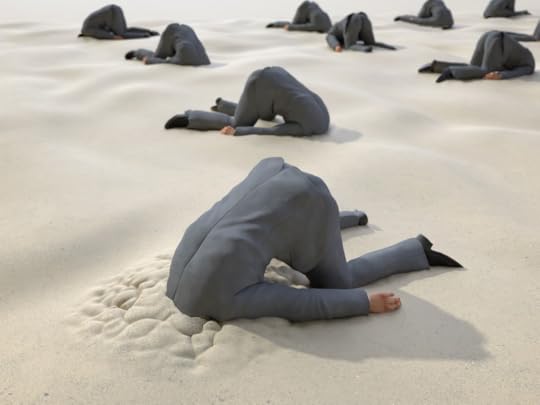
A common misconception in today’s fast-paced work culture is the belief that busyness equals productivity. We often equate being constantly occupied, multitasking, or working long hours with being productive, but this couldn’t be further from the truth. Busyness is about activity, while productivity is about results. When we are busy, we’re often scattered, reacting to distractions, emails, and endless meetings, without making significant progress on what truly matters. In contrast, productivity is about focusing on high-impact tasks that move the needle forward, which is precisely where the concept of flow comes in.
Flow is the antidote to busyness because it requires focused attention and deep work—the very elements that drive true productivity. When you’re in a state of flow, you're completely immersed in a meaningful task, leveraging your skills to meet a challenge that stretches your abilities. This level of engagement eliminates the superficial busyness and replaces it with a sense of purpose and progress. It’s not about doing more; it’s about doing what matters most with undivided attention and energy. Therefore, cultivating flow allows you to operate at your highest level of productivity, transforming how you work and the quality of what you produce.
Leaders who understand this crucial distinction between busyness and productivity can create environments where flow becomes a natural part of the workday. By encouraging focused work, reducing unnecessary distractions, and emphasizing tasks that align with each team member’s strengths, leaders can help their teams shift from a culture of perpetual busyness to one of intentional, results-driven productivity. This shift doesn’t just lead to higher performance; it also fosters greater job satisfaction, engagement, and overall well-being, allowing individuals and teams to achieve their best work in a sustainable, fulfilling way.
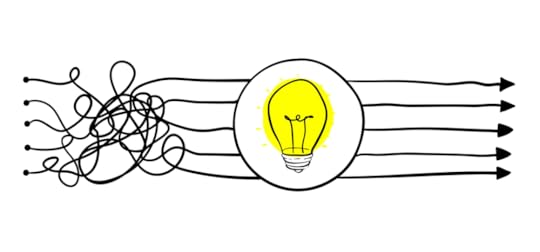
As a leader, finding your own flow state is crucial for staying energized, making better decisions, and avoiding burnout. But it doesn’t happen by accident; it requires a deliberate focus on aligning your time, priorities, and energy. Here are a few strategies to help you get into flow:
Clarify Your Purpose: Flow starts with knowing your “why.” Purpose drives focus, and focus is the gateway to flow. As a leader, having clarity on your organization’s mission and how your role contributes to it will help you immerse yourself fully in your tasks.
Eliminate Distractions: Flow can only happen when distractions are minimized. Prioritize deep work by scheduling blocks of uninterrupted time. Turn off notifications, close your email, and trust your team to handle issues while you’re in this mode.
Match Challenges to Skill Levels: Flow requires a balance between the difficulty of the task and your own skill level. Tasks that are too easy lead to boredom, while tasks that are too hard create anxiety. To maintain flow, take on projects that stretch your abilities but don’t overwhelm you.
Manage Your Energy, Not Just Time: Flow is easier to achieve when you’re in your optimal energy zone. Understand your body’s natural rhythms, and align your most challenging tasks with periods when your energy is highest.

While finding your own flow state is important, exceptional leaders create environments that enable their team members to experience flow as well. When your entire team can consistently access flow, productivity, engagement, and overall morale will skyrocket.
Here’s how you can support your team in finding their flow:
Focus on Strengths
The combination of deep understanding of what people do well and the unique talents and strengths they utilize to perform these activities is the first step to activating flow. By helping others identify their areas of speciality and the specific tools they possess to achieve success more often than not, leaders point their team members in the direction of staying in the flow state.
Foster Autonomy and Trust
Micromanaging is a surefire way to disrupt flow. Flow happens when individuals have the freedom to fully engage with their tasks without constant oversight. Create a culture of autonomy by trusting your team members to manage their own work. This doesn’t mean leaving them to their own devices—it’s about giving them the space to succeed while offering guidance when needed.
Set Clear, Challenging Goals
People enter flow when their skills are aligned with a meaningful challenge. As a leader, it’s essential to provide your team with clear objectives that stretch their abilities. At the same time, break down large, intimidating projects into smaller, more manageable milestones. This gives team members a sense of progress and a chance to experience that satisfying feeling of mastery along the way.
Encourage Focused Work
The modern workplace is full of distractions, from emails to endless meetings. Leaders should create a culture that values deep, focused work. Start by cutting down on unnecessary meetings, encouraging blocks of uninterrupted time, and protecting your team’s space for high-priority work.
Promote Psychological Safety
Flow requires people to take risks, try new approaches, and push their limits. But this can only happen in an environment where failure is seen as a part of learning, not something to be feared. As a leader, foster psychological safety by encouraging open communication, offering constructive feedback, and celebrating both successes and lessons learned from failures.
Flow Transforms Workplaces
When leaders prioritize flow for themselves and their teams, work becomes less about surviving the day and more about thriving in it. Flow transforms how we experience our tasks, making them more fulfilling, engaging, and impactful. This shift from drudgery to immersion isn’t just good for morale—it’s a proven driver of performance and innovation.
Modern leaders must recognize that busyness is the enemy of real progress. Filling the day with endless tasks, meetings, and distractions may give the illusion of productivity, but it keeps both leaders and teams stuck in a reactive cycle. Achieving flow, however, is the key to breaking free from this trap.
Flow is where real, meaningful work happens—it’s the state that drives innovation, deepens focus, and amplifies results. Leaders who can cultivate flow for themselves and their teams unlock the potential for sustained high performance, creativity, and engagement.
The ability to move beyond busyness and create a culture of flow is no longer a nice-to-have; it’s a strategic imperative. In a world that demands both agility and excellence, leaders must prioritize focused, intentional work that aligns with their team's strengths and goals. When flow becomes the norm, it transforms the way work gets done, turning daily tasks into opportunities for growth and mastery. By helping teams achieve flow, leaders foster environments of deep engagement and purpose—where productivity is no longer measured by hours worked, but by the impact of the work itself. This shift is the foundation for long-term success, both for individuals and organizations.
By finding your own flow and helping your team do the same, you’re not just leading—you’re inspiring a culture of excellence, focus, and fulfillment. And that, ultimately, is the foundation for sustainable success.
Omar L. Harris is the managing partner at Intent Consulting , a firm dedicated to improving employee experience and organizational performance and author of Leader Board: The DNA of High-Performance Teams; The Servant Leader's Manifesto; Be a J.E.D.I. Leader, Not a Boss: Leadership in the Era of Corporate Social Justice, Equity, Diversity, and Inclusion; Leading Change: The 4 Keys; Hire the Right W.H.O.M.: Sourcing the Right Team DNA Every Time; and The J.E.D.I. Leader's Playbook: The Insider's Guide to Eradicating Injustices, Eliminating Inequities, Expanding Diversity, and Enhancing Inclusion available for purchase in ebook, print, and audio on Amazon.com . Please follow him Instagram , Twitter , and/or his website for more information and engagement.
September 24, 2024
The Power of Holding Space for Others: A Key to Servant Leadership

Leadership today is too often reduced to strategy, execution, and metrics. But in the relentless pursuit of outcomes, we risk neglecting one of the most powerful drivers of success: the ability to hold space for others. As servant leaders, our greatest impact comes not from what we accomplish alone, but from how we create environments where individuals feel seen, valued, and supported. This is the bedrock of sustainable, long-term success in human-centered leadership.

The concept of "holding space" has deep roots in practices like mindfulness, emotional intelligence, and therapeutic disciplines such as counseling and psychology. At its essence, holding space is about creating a safe, non-judgmental environment where individuals can freely express their thoughts, emotions, and vulnerabilities. This idea stretches back to ancient spiritual traditions—such as meditation and mindfulness—that emphasize the importance of being fully present, empathetic, and engaged in deep listening. These traditions teach us that to truly serve others, we must be willing to sit with them in their experiences, offering compassion and understanding without the urge to control, solve, or fix.
Holding space is more than just a practice; it’s a profound, human-centered approach that has stood the test of time. And today, it has found its rightful place in modern leadership as a transformative force. In the business world, it has become a key to unlocking trust, building authentic connections, and sparking creativity and innovation.
Let’s be clear: holding space is not just about showing up. It’s an intentional, deliberate act of creating an environment where individuals feel safe to express their challenges and emotions without the fear of being judged. As leaders, when we hold space, we offer empathy, respect, and patience. This simple but powerful action creates a ripple effect that fosters engagement, trust, and ultimately, innovation within our teams.
Think back to a time when someone truly listened to you—without interruption, judgment, or a need to solve your problem. How did that make you feel? Respected. Valued. Understood. Now, imagine scaling that experience across an entire team or organization. When leaders consistently hold space, they cultivate a culture of psychological safety where individuals are empowered to take risks, offer bold ideas, and even admit mistakes. This is the kind of leadership that elevates performance, fosters loyalty, and drives sustainable success.

Servant leadership emphasizes that leaders should prioritize the growth, well-being, and empowerment of their people. Holding space perfectly aligns with these principles, as it requires leaders to put the needs of others first by being emotionally present and providing a supportive environment that fosters personal and professional growth. It’s about shifting from “How can I be served?” to “How can I serve?” At its core, holding space is a selfless act. It requires us to step back, listen deeply, and allow others the room to be vulnerable.
In my own leadership journey, I’ve witnessed how holding space transforms teams and organizations. When leaders create an atmosphere of genuine care and openness, employees feel more connected to their work, more loyal to the organization, and more committed to achieving collective goals. It’s the difference between employees who are merely compliant and those who are truly engaged.

Some might argue that holding space is a “soft” skill and that the focus should remain on driving hard business results. But the truth is, there’s a direct correlation between how people feel and how they perform. Research has shown that employees who feel supported by their leaders are more productive, more innovative, and more willing to go the extra mile.
Consider Google’s landmark study on team effectiveness, which found that the most successful teams shared one key characteristic: psychological safety. When employees feel safe to speak up, share ideas, and admit missteps, they collaborate more effectively and drive better business outcomes. Holding space is a vital part of creating this safety.

Becoming a leader who holds space for others requires intentionality and practice. Here are a few strategies to help you get started:
Practice Invested Listening: When someone comes to you with a concern or idea, focus on truly hearing them. Put aside distractions and resist the urge to jump in with solutions. Sometimes, people just need to be heard.
Create Safe Boundaries: Establishing clear boundaries allows individuals to feel secure in their conversations with you. Let your team know that what they share in confidence will stay in confidence.
Resist the Need to Fix: As leaders, we often feel compelled to offer solutions immediately. But holding space means giving people the time and room to process their thoughts and feelings without immediately jumping to action.
Be Present and Available: Servant leaders make themselves available for their teams, even in busy times. Your presence communicates that you care and that you value what your team has to say.
Encourage Vulnerability: Lead by example. When leaders show vulnerability, they give permission for others to do the same. This openness can lead to deeper connections and more innovative problem-solving.

The act of holding space creates a ripple effect throughout your organization. When leaders model empathy and understanding, they inspire their teams to do the same. This, in turn, fosters a culture of collaboration, trust, and respect—key ingredients for long-term success.
By holding space for others, we honor the human side of work, building environments where people can thrive and contribute their best. Servant leadership isn’t just about achieving results—it’s about how we achieve them. And when we lead by holding space, we not only drive better outcomes but also create a lasting, positive impact on the lives of those we lead.
Omar L. Harris is the managing partner at Intent Consulting , a firm dedicated to improving employee experience and organizational performance and author of Leader Board: The DNA of High-Performance Teams; The Servant Leader's Manifesto; Be a J.E.D.I. Leader, Not a Boss: Leadership in the Era of Corporate Social Justice, Equity, Diversity, and Inclusion; Leading Change: The 4 Keys; Hire the Right W.H.O.M.: Sourcing the Right Team DNA Every Time; and The J.E.D.I. Leader's Playbook: The Insider's Guide to Eradicating Injustices, Eliminating Inequities, Expanding Diversity, and Enhancing Inclusion available for purchase in ebook, print, and audio on Amazon.com . Please follow him Instagram , Twitter , and/or his website for more information and engagement.
September 10, 2024
Table Stakes: Why Hygiene Factors Are the Foundation for Leadership Success

For leaders today, the conversation often revolves around the big ideas: catalyzing with purpose, driving motivation, fostering innovation, and creating a culture of excellence. These are the outcomes we aspire to achieve and the legacies we aim to leave behind. However, what frequently gets overlooked are the foundational elements that enable these higher-level goals—the hygiene factors. These are the basic yet critical conditions that prevent dissatisfaction and create an environment where productivity and engagement can flourish. Without focusing on these hygiene factors, even the most inspiring leader will struggle to make a lasting impact on productivity, engagement, or culture.
The term "hygiene factors" originates from Frederick Herzberg's Two-Factor Theory of motivation, which he developed in the late 1950s. Herzberg, a psychologist, conducted research to understand what causes satisfaction and dissatisfaction in the workplace. He concluded that there are two distinct sets of factors that influence employee motivation and job satisfaction: motivators and hygiene factors.
Motivators (also called satisfiers) are intrinsic factors that lead to higher motivation and job satisfaction when present, such as achievement, recognition, meaningful work, and personal growth.
Hygiene factors (also called dissatisfiers) are extrinsic factors that don't necessarily motivate employees when present, but can lead to dissatisfaction if they are absent or handled poorly. Herzberg likened these to hygiene in the medical sense: just as good hygiene prevents illness but doesn't necessarily make someone healthy, hygiene factors in the workplace prevent dissatisfaction but don’t actively create motivation.
Understanding hygiene factors is crucial because they must be managed properly to avoid dissatisfaction, creating a stable environment where motivators can then thrive and drive employee performance. The truth is, leadership isn’t just about inspiration; it’s also about ensuring that the basic needs of employees are met so they can fully engage with the vision of the organization.
So, let’s take a closer look at what these table stakes are and why they’re non-negotiable for leadership success.

For those familiar with the trust equation (credibility + reliability + professional intimacy / by self-orientation) - we understand why reliability is a huge factor in garnering trust for leaders. Being dependable and consistent in your actions is crucial. Employees need to know that they can count on you—whether it's delivering on promises, meeting deadlines, or being present when they need you most. Without reliability, trust erodes, and with it goes the engagement and willingness of your team to go the extra mile.
To increase reliability as a leader, it's crucial to focus on several key areas.
First, consistent communication is essential for aligning the team and avoiding ambiguity, ensuring everyone knows what is expected. Following through on commitments, delivering on promises, and setting realistic expectations help build trust over time. Effective time management allows you to meet deadlines and be available for your team when they need support.
Reliability also stems from being accessible, maintaining a consistent leadership style, and staying organized to manage responsibilities efficiently. Regular self-assessment and feedback from your team further refine your reliability, ensuring that you're continuously improving. By consistently demonstrating these behaviors, leaders can earn the trust of their teams and create a stable environment for success.

Leaders are responsible for setting the tone, and that tone must include accountability. At the end of the day someone must make decisions, take action, and ensure impact. Dodging accountability is a very toxic trait for a modern leader. Equally as toxic is lacking the ability to assign and ensure accountability of others. When accountability is present, employees feel a sense of fairness and integrity, which encourages them to hold themselves to a higher standard as well.
Increasing accountability as a leader starts with setting clear expectations and creating a culture where ownership is valued. Leaders must lead by example, consistently demonstrating that they take responsibility for their decisions and actions, fostering a similar attitude within the team. Establishing transparent goals and defining individual roles helps team members understand their responsibilities, making it easier to track progress and hold themselves accountable.
Regular feedback sessions, both formal and informal, create opportunities to discuss progress, challenges, and areas for improvement, reinforcing a sense of ownership over tasks. It's also important to ensure that accountability is tied to outcomes, meaning individuals should not only take credit for successes but also work collaboratively to resolve issues when things go wrong. Empowering the team by giving them the autonomy to make decisions builds confidence and reinforces accountability, while establishing clear consequences for both meeting and missing objectives ensures that accountability is felt across the organization.
Finally, creating a supportive environment where accountability is not about blame but about learning from mistakes ensures that everyone remains engaged in the process of continuous improvement.

Communication is fundamental for leaders. The ability to not only clearly convey information but to also ensure high understanding and alignment is key. Miscommunication is a breeding ground for inefficiency and frustration. Without clarity, employees can’t prioritize effectively or understand how their work contributes to the bigger picture. A leader who masters clear communication ensures everyone is rowing in the same direction.
Increasing clarity in communication requires deliberate effort and consistent practices from leaders. First, it’s essential to tailor messages to the audience, using language that is direct, simple, and free from unnecessary jargon. Leaders should ensure that the purpose of the communication is clear, outlining key objectives and expectations in a way that leaves no room for ambiguity. Invested listening is equally important—leaders must encourage questions and be open to feedback, ensuring that everyone has understood the message correctly.
Visual aids, summaries, or written follow-ups can also help reinforce verbal communication, providing clear takeaways for complex topics. Regularly checking in with the team to address any confusion and adapting the communication style based on their feedback helps maintain transparency and alignment. By fostering an environment where open dialogue is encouraged and clarity is a priority, leaders ensure that their messages resonate effectively, enhancing team performance and cohesion.

Leadership isn’t about pushing your team to the brink; it’s about managing their energy so they can deliver sustained high performance. Prioritizing work-life integration creates an environment where employees feel valued as individuals, not just as resources. Leaders who promote balance protect their team's mental and physical well-being, reducing burnout and turnover.
To increase work-life integration within a team, leaders must first model this balance in their own lives. By prioritizing their own well-being and setting clear boundaries between work and personal time, leaders demonstrate that it’s not only acceptable but essential for long-term success. This approach creates a culture where employees feel empowered to manage their time more flexibly, knowing that their leader values a healthy work-life integration.
Leaders can encourage this by promoting flexible work schedules, supporting remote work options, and setting clear expectations around availability, so employees don’t feel pressured to be "always on." Additionally, regularly checking in on employee workloads and adjusting expectations as needed helps prevent burnout. Open communication about work-life challenges also fosters a supportive environment, where employees can discuss their needs and find solutions without fear of judgment.
By leading by example and creating an environment that supports balance, leaders pave the way for increased well-being, productivity, and engagement across the team.

These hygiene factors are not just “nice to haves” or administrative checkboxes—they are the table stakes of leadership. Without these elements in place, even the most motivated team will fail to thrive. The reality is that leadership influence is built on the foundation of trust, respect, and support. When hygiene factors are emphasized and consistently maintained, leaders unlock the potential to truly inspire, influence, and drive higher levels of engagement and productivity.
In today’s fast-paced business world, leaders must go beyond visionary thinking to focus on the fundamentals. The true measure of leadership is not just in the big wins but in how well the everyday table stakes are managed. Great leaders recognize that these hygiene factors are non-negotiable and essential to creating an environment where people can do their best work. Only then can you lead a team that is engaged, empowered, and primed for success.
If you want to investigate and improve your hygiene factors, executive coaching is a very effective strategy to understand where you are, where you should be, and how to bridge the gap.
Omar L. Harris is the managing partner at Intent Consulting , a firm dedicated to improving employee experience and organizational performance and author of Leader Board: The DNA of High-Performance Teams; The Servant Leader's Manifesto; Be a J.E.D.I. Leader, Not a Boss: Leadership in the Era of Corporate Social Justice, Equity, Diversity, and Inclusion; Leading Change: The 4 Keys; Hire the Right W.H.O.M.: Sourcing the Right Team DNA Every Time; and The J.E.D.I. Leader's Playbook: The Insider's Guide to Eradicating Injustices, Eliminating Inequities, Expanding Diversity, and Enhancing Inclusion available for purchase in ebook, print, and audio on Amazon.com . Please follow him Instagram , Twitter , and/or his website for more information and engagement.
August 15, 2024
The Light at the End of the Hallway (A Leadership Tribute to My Father)

One of my earliest and most enduring memories was waking up pre-dawn and seeing the bathroom light on at the end of the hallway. Even at the tender age of three, I knew my father was in the bathroom going through his morning ablutions, preparing for Fajr prayer - the first of the five daily supplications for Muslims. That light meant that a new day had dawned. It also signified something that would turn out to be far more meaningful in my life - the power of devotion.
My father showed his dedication in many ways - from his strong religious beliefs and love for our mother during their forty-four years of marriage (until her death), to his involvement in the Islamic community in Rock Hill, SC, to his successful career as an engineer, to his care for his extended family and us, his children. He was as reliable as a lighthouse and a stoic figure who preferred leading through actions rather than words. He was the definition of leading by example.
Having been brought up in a dedicated Christian family in Pittsburgh, PA, by his father - a respected figure in the community, and his mother - a pioneering entrepreneur, he experienced a comfortable and stable middle-class upbringing centered around family and fellowship. He attended Oberlin College - a progressive liberal arts institution that had been one of the earliest to admit Black students back in the 1830's! However, growing up during a turbulent period in American history - the dawn of the Civil Rights Movement, he felt the need for a deeper connection to his roots.
With a powerful sense of Afro-centric pride and a growing dissatisfaction with the racial status quo, he felt compelled to break away from his conservative rearing in search of a more radical transformation. He dropped out of college and considered joining the Black Panther movement, eventually finding his place in the Nation of Islam in 1970 at the age of twenty-four. The Nation brought him purpose and inner peace which broadened when he met and married his first wife and gave birth to my brother, Kamau whom he originally named Samuel after himself and his father before him.
The Nation of Islam eventually fell victim to corrupted influences within which led my father to Sunni Islam and an embrace of a path for which he would devote the rest of his days. It wasn't an easy path - his parents and relatives didn't understand his shift, but they never rejected him for it. This conversion led him to a disruption in his young marriage which would culminate in a difficult divorce. And it was in this period of significant transition that he would meet my mother - the love of his life who had also come to Islam after a very tumultuous childhood and adolescence.
Falling in love with my mother caused further familial rifts due to her less than pristine upbringing, already having two sons of her own, and a lack of formal education. They truly came from two different worlds, but they found something to hold on to in each other. They quickly married and soon thereafter gave birth to me and then my sister. Then they left the confines of Pittsburgh and embarked on a life together that would take them from Pittsburgh to Charleston, WV and later to Lake Charles, LA, Houston, TX, and eventually Rock Hill, SC where my father found the community for which he'd been seeking for many years.
I never met the version of my father who rebelled from his upbringing, dropped out of school, nearly became a Black Panther, sold Final Call newspapers and bean pies in Pittsburgh as newly minted Muslim Samuel 2X, lived in New York City and worked for TWA airlines. The edition of him who danced and sang along to Aretha Franklin records at parties with his college friend Lamont. The smoker!
This version of my father almost seems like a myth to me - because the man who raised me was the light at the end of the hallway version. A man who committed to a woman from the other side of the tracks with two young sons while having a toddler of his own. The man who worked three jobs to finish his college degree in order to keep food on the table. The man who woke us each morning with the call to prayer. The stoic, self-effacing, observant mathematic savant who read voraciously and loved Star Trek. The bread maker who could cook up a mean chili. The lover of pound cake, ice-cream, and coffee. The man who packed us into a car each December to drive home to be with his extended family even though he no longer celebrated Christmas. The devout Muslim who attended Hajj and fasted for Ramadan every year after his conversion. The beacon version who signified discipline and self-sacrifice in devotion to his faith, family, and community.
Learning about his significant personal evolution was cathartic to me later in life because the example my father set was a hard act to follow. He raised the bar so high it seemed impossible to achieve. But that's what daily commitment and consistency manifests - a character etched in the ethos of chopping wood and carrying water no matter what. It's the pattern of twenty-mile marching that manifests a level of progress that is difficult to emulate.
His religious identity became the idea that would define him. It permeated every dimension, interaction, and relationship in his life. But it was something personal to him. He didn't demand that we match his zeal. He didn't force us to adhere to his standard. He merely set the example and allowed us to witness what would spool forth from a lifetime of consistency.
My father was the very essence of influence. He was humility and will in action. He was the definition of love in verb form. He was steeped in values, morals, and principles.
I realized that my passion for leadership is a natural extension of the effect of my father on my life. By learning about leading - I came to understand how I'd been led. It is now apparent to me that while authoring my various books, developing keynote lectures, crafting training, and consulting - what I've actually been doing is codifying my father's living example and allowing the world to bear witness. My father got his principles from Islam - I got mine from watching him.
His final lesson to me was enduring the eventual hardship of aging with illness. Since his diagnosis of interstitial lung disease and scleroderma four years ago it has been a process of dealing with loss - of lung function, swallowing ability, significant weight, independence, ability to eat by mouth, and eventually life itself. My father confronted all of this with dignity, humility, and faith. When he could no longer drive to the masjid he prayed at home. When he could no longer stand and bend and kneel, he prayed on the side of the bed. When he could no longer exit the bed, he prayed lying down. But he did not stop believing and acting on his faith.
He was cogent and articulate until the end and faced death as courageously as he lived his life. He allowed himself to be cared for - by the nurses in the hospital and later by my sister and I at home. He didn't rail against the constant indignities of malignant illness - the bed baths, diaper changes, constant discomfort, inability to do for himself beyond the bare minimum. He accepted this as a stage of his life without accepting that his demise was inevitable. He did his absolute best to stay with us as long as he could.
We buried him yesterday in the same cemetery that accepted my mother four years ago. His community was there in full force with barely a day's notice to make plans to attend his service. The fellowship he enjoyed was significant. I saw my father through new eyes once again. He never stopped surprising me even after his passing.
There were stories of the man who helped found the first masjid in Rock Hill. The man who was often the first to open the masjid in the morning and who never missed a prayer service if he was in town and able. The man who continued to make the round trip to Rock Hill several times a day even after he moved to live with me in Gastonia an hour away. The man who gave life lessons to other brothers in the community. The man who taught himself Arabic and became so proficient that he could lead others in prayer. The man who never quarreled with anyone and who would stand up and leave if others began to bad mouth someone in the community. The servant leader who demanded nothing and gave everything.
That's who my father was and who he will always be to me. Not just Dad or Pops Tops as I affectionately called him after a hat my brother gave him one Father's Day. Even though he's no longer with us - I will leave my bathroom light on each night so I can awake and remember that true strength does not come from our muscles - it emanates from our ability to commit ourselves fully to ideals that lead to positive impacts for us and those around us.
I am so grateful that you were my father! I love you Dad!

Samuel Harris 1946-2024
O Allah, forgive my father Samuel Harris and elevate his station among those who are guided. Send him along the path of those who came before, and forgive us and him, O Lord of the worlds. Enlarge for him his grave and shed light upon him in it.
August 5, 2024
Elon Musk: A Descent into Megalomania
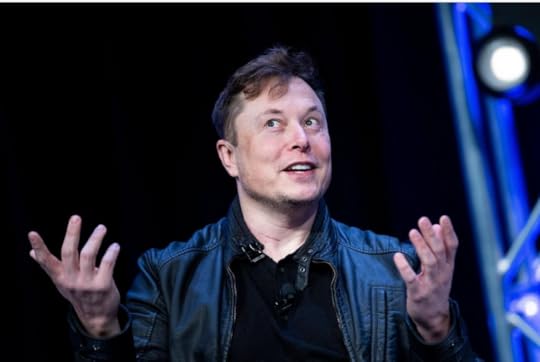
Megalomaniac: A person obsessed with their own power.
Elon Musk's trajectory from a tech-savvy entrepreneur to a polarizing figure in global business and culture is both remarkable and unsettling. Early in his career, Musk was lauded as a visionary committed to addressing humanity's most pressing challenges—whether through electric vehicles, renewable energy, or the exploration of space. However, as his influence and wealth have grown, so too has his reputation for erratic behavior, self-aggrandizement, and an increasing detachment from the progressive ideals that once defined his public persona.
In this article, we explore the journey of Elon Musk, examining how he went from a progressive idealist focused on improving the world to a figure increasingly driven by power, ego, and a need for validation.

Father Errol Musk and newborn Elon
Elon Musk was born in Pretoria, South Africa, in 1971, into a family that was both affluent and fractured. His father, Errol Musk, was an engineer, while his mother, Maye Musk, was a model and dietitian. Despite this seemingly privileged upbringing, Musk's childhood was far from easy. He was often bullied at school and had a strained relationship with his father, which would later be cited as a source of deep emotional trauma.
Elon Musk's family background is as unconventional as the man himself. His maternal grandfather, Dr. Joshua Haldeman, was a Canadian chiropractor and amateur archeologist who moved his family to South Africa in the 1950s. Haldeman was a fearless adventurer, piloting a small single-engine plane on expeditions deep into Africa to hunt for the lost city of the Kalahari Desert. Musk's adventurous spirit and inclination toward risk-taking may very well be an inheritance from his grandfather.
On his father’s side, there’s a more controversial legacy. Musk’s paternal ancestors include individuals who were involved in nefarious activities, including rumored connections to pirate gangs operating off the coast of Mozambique in the 18th century. While these tales are often shared within the Musk family with a mix of pride and mystery, they paint a picture of a lineage steeped in rebellion and lawlessness—a stark
contrast to the polished image of modern-day entrepreneurs.
Musk's early interest in technology was evident; he taught himself computer programming at a young age and created a video game at 12. This early display of genius hinted at the groundbreaking work he would later pursue. After moving to Canada for university and eventually transferring to the University of Pennsylvania, Musk's focus on using technology to solve big problems became clear. He was driven, ambitious, and deeply interested in how innovation could better humanity—a far cry from the person he would later become.
Elon Musk's relationship with his father, Errol Musk, is perhaps one of the most complex and troubling aspects of his upbringing. Errol, a South African electromechanical engineer, was by all accounts a brilliant man, but his personality and actions left deep emotional scars on Elon. The elder Musk was reportedly domineering and at times emotionally abusive, instilling a sense of fear and inadequacy in his young son.
In various interviews, Elon has described his father as "a terrible human being" and recounted instances where Errol would make life miserable for everyone around him. This tumultuous relationship reached a peak when Errol fathered a child with his own stepdaughter, a scandal that shocked the family and further alienated Elon from his father. The emotional toll of these experiences fueled Elon’s drive to prove himself, to escape his father’s shadow, and to build a legacy that was entirely his own.
Elon Musk's journey to America began with a deep-seated belief that the United States was the place where he could truly achieve his dreams. Growing up in South Africa, Musk was intensely aware of the limitations imposed by the country's socio-political environment, especially during the apartheid era. As a teenager, he became obsessed with the idea of moving to the U.S., viewing it as the land of opportunity where anyone with enough determination and ingenuity could make a mark on the world.
At the age of 17, Musk made the bold decision to leave South Africa for Canada, where his mother, Maye, was born. He obtained Canadian citizenship through his mother, which provided a pathway to eventually reaching the United States. With just a backpack and a few thousand dollars, Musk arrived in Canada, staying with relatives while he figured out his next steps.

After graduating from Penn University, Musk briefly pursued a Ph.D. in applied physics at Stanford University, but he dropped out after just two days, realizing that the internet boom held more immediate potential for changing the world. His decision to leave Stanford was a gamble, but it reflected Musk’s instinct for recognizing pivotal moments in technology and his desire to be at the forefront of innovation.
Musk moved to Silicon Valley with his brother, Kimbal, and together they set out to create their first tech venture. They lived in a small office, showering at the local YMCA, and worked tirelessly to develop the software that would eventually become Zip2. The idea behind Zip2 was to create an online city guide for newspapers, a concept that was ahead of its time. Musk’s vision was to help businesses transition from traditional advertising to digital platforms, laying the groundwork for what would become a digital revolution in local commerce.
After selling Zip2 for nearly $300 million, Musk's next big move was into the financial technology sector with X.com, which would later become PayPal. While Musk is often credited as a PayPal founder, the reality is more complex. PayPal was originally founded by Max Levchin, Peter Thiel, and Luke Nosek. Musk's company, X.com, merged with PayPal, and after a power struggle, Musk was ousted as CEO by the board in favor of Thiel. However, Musk’s financial gain from the sale of PayPal to eBay in 2002 provided the capital needed for his next ventures, Tesla and SpaceX.
Tesla, too, is a company where Musk’s role as “founder” is often overstated. Tesla was actually founded by Martin Eberhard and Marc Tarpenning in 2003. Musk joined later as an investor and led the company’s first major funding round, which eventually gave him the leverage to take control. Eberhard was forced out in 2007, and Musk assumed the mantle of CEO, pushing Tesla toward mass-market electric vehicles. Under Musk's leadership, Tesla is shooting for full autonomous self-driving which would revolutionize transportation for the foreseeable future.
Musk was also originally involved in the founding of OpenAI, a research organization aimed at ensuring that artificial intelligence benefits all of humanity. However, differences in vision and governance led to Musk stepping away from the organization in 2018. Musk’s departure was reportedly due to disagreements over the direction of the company and his desire to take control, a pattern that had already emerged in his previous ventures. After leaving OpenAI, Musk became increasingly critical of the organization and artificial intelligence in general, positioning himself as a lone voice of reason amidst what he portrayed as a reckless industry.
SpaceX, Musk’s foray into space exploration, was perhaps his most genuine passion project. The idea for SpaceX was born out of Elon Musk's fascination with space and his deep concern for humanity's long-term survival. After selling PayPal in 2002, Musk had the financial resources to pursue his dream of making humanity a multi-planetary species. His initial plan was to send a small greenhouse to Mars, dubbed the "Mars Oasis," to inspire public interest in space exploration and secure increased funding for NASA. However, during a trip to Russia to purchase refurbished ICBMs (Intercontinental Ballistic Missiles) to use as launch vehicles, Musk encountered difficulties—Russian officials mocked him, and the price was too high.
SpaceX's early days were fraught with challenges. The company operated out of a small warehouse in El Segundo, California, where a team of young engineers worked tirelessly to develop the Falcon 1 rocket. Musk was hands-on, often working 80 to 100 hours a week and demanding the same dedication from his team. His leadership style was intense, pushing his engineers to innovate quickly and solve problems on the fly.
As SpaceX conquered the challenges of rocket development, Musk also envisioned a global satellite internet network—Starlink. The idea was to deploy thousands of small satellites in low Earth orbit to provide high-speed internet access across the globe, particularly in remote or underserved areas. The first batch of Starlink satellites was launched in May 2019, and by 2021, SpaceX had deployed over 1,500 satellites, rapidly expanding coverage. While initially met with skepticism, Starlink quickly proved its value, especially in areas with limited connectivity options.
One of the most significant and unexpected uses of Starlink emerged during the Ukraine war in 2022. As Russian forces invaded Ukraine, they targeted critical infrastructure, including communications networks, to disrupt the Ukrainian government and military operations. In response to a plea from Ukrainian officials, Musk activated Starlink service over Ukraine and sent thousands of Starlink terminals to the country, providing a lifeline for communication in the midst of chaos.
Starlink proved to be a game-changer. Ukrainian forces, as well as civilians, used the network to maintain communication, coordinate defense efforts, and share real-time updates with the world. It allowed the Ukrainian military to operate drones, coordinate artillery strikes, and ensure continuous communication even as Russian forces attempted to jam traditional communication channels. The resilience and reliability of Starlink underlined its potential as a critical tool in modern warfare, earning Musk both praise and controversy for his involvement.
For many years, Musk was seen as a visionary who could inspire teams to accomplish the impossible. His drive to disrupt industries and challenge the status quo won him admiration and respect, even as his management style grew increasingly demanding and his ambitions, grander. His group of companies—Tesla, SpaceX, Neuralink, The Boring Company, and Starlink—collectively and individually have reshaped industries and pushed the boundaries of what technology can achieve.
Tesla has revolutionized the automotive industry, accelerating the transition to electric vehicles and renewable energy. SpaceX has not only revived interest in space exploration but also made significant strides toward making humanity a multi-planetary species. Neuralink is pioneering brain-machine interfaces that could transform the treatment of neurological conditions, while The Boring Company aims to redefine urban transportation with its innovative tunneling solutions. Starlink, through its global satellite network, is bridging the digital divide, providing internet access in remote areas and playing crucial roles in global events Together, these companies reflect Musk's ambition to tackle some of humanity's most pressing challenges, though they also highlight the complex interplay of innovation, controversy, and the immense impact of his vision on the future.
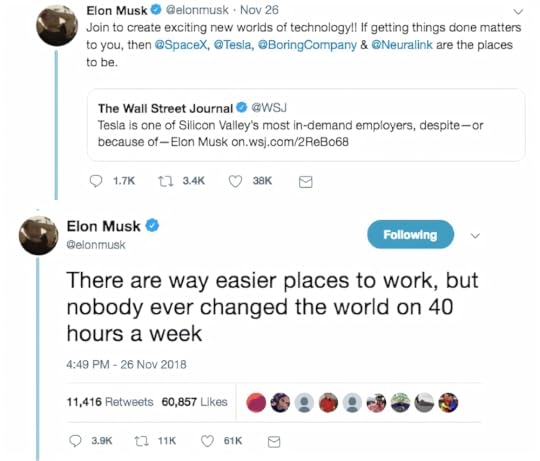
Musk is notorious for his relentless work ethic, which he expects his employees to match. At Tesla, SpaceX, and his other companies, Musk has frequently called for "all hands on deck" blitzes—periods of intense work where employees are expected to put in long hours, sometimes around the clock, to meet ambitious deadlines. These blitzes often come in response to crises or when Musk wants to push through a significant milestone, such as ramping up production of the Tesla Model 3 or preparing for a crucial SpaceX launch.
At Tesla, reports of a toxic workplace became particularly prominent during the Model 3 production ramp-up. Employees described an environment where unrealistic deadlines were the norm, and those who couldn't keep up were often let go. The pressure was so intense that some employees claimed they had to choose between their jobs and their health, with several reporting stress-related illnesses and injuries.
Similarly, at SpaceX, the push to achieve seemingly impossible goals has created a high-stakes atmosphere. While many employees are driven by a shared sense of purpose and the excitement of working on cutting-edge technology, the toll it takes is significant. Former SpaceX employees have reported a "burnout culture," where the relentless pace and long hours are celebrated, but at the cost of personal well-being and job satisfaction.
Musk’s management style, which often includes public criticism of employees who don’t meet his expectations, has also been cited as a factor contributing to the toxic environment. While some thrive under the pressure and view Musk’s demands as part of what makes his companies successful, others find the environment unsustainable, leading to high turnover rates and frequent burnout.
While Musk’s intense focus and high expectations have led to groundbreaking achievements, they have also contributed to what many ex-employees describe as a toxic work environment. At Tesla and SpaceX, former employees have spoken out about the extreme pressure, fear of failure, and the lack of work-life balance. Some describe a culture where employees are constantly on edge, afraid to speak up or challenge Musk’s directives for fear of being reprimanded or fired.
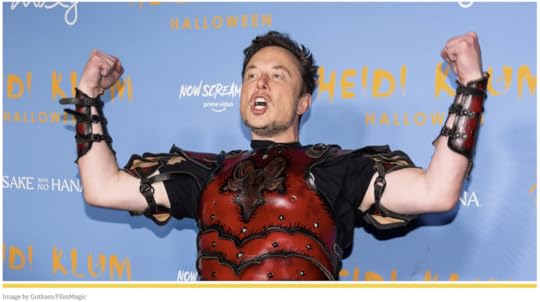
As Musk’s empire expanded, cracks began to show in his public image. His leadership style became increasingly authoritarian, with reports of toxic work environments at both Tesla and SpaceX. Employees described a culture of fear, where failure was not an option and dissent was not tolerated. These issues were compounded by Musk’s public behavior, which began to reveal a more erratic and self-centered personality.
Elon Musk’s political trajectory—from being one of President Barack Obama’s biggest advocates to aligning more closely with the values and rhetoric associated with former President Donald Trump—illustrates a significant shift not only in his political stance but also in his broader worldview. This evolution can be seen as reflective of a deeper transformation in Musk’s character, moving from a focus on serving humanity to a more self-centered, ego-driven approach that aligns with the traits of growing megalomania.
This shift in Musk’s political alignment can be seen as part of a broader transformation in his approach to leadership and innovation. In the Obama years, Musk’s work was often framed as serving humanity—whether through advancing electric vehicles to combat climate change, promoting space exploration as a means of ensuring humanity’s long-term survival, or supporting renewable energy initiatives. His focus was on leveraging technology to solve some of the world’s most pressing problems, with a vision that extended beyond his personal interests.
However, as Musk’s wealth and influence grew, so did his sense of invincibility and self-importance. His increasing alignment with Trump’s ideology reflects a shift toward a more self-serving approach, where maintaining his own power, autonomy, and public image took precedence over the broader social good. Musk’s actions, such as his public attacks on unions, his disregard for safety regulations, and his growing hostility toward progressive causes, suggest a pivot from a mission-driven leader to one more
concerned with preserving his own freedom to operate without constraints.
This shift is emblematic of growing megalomania, where Musk’s sense of self and his belief in his own ideas began to overshadow the collective ideals he once championed. His rhetoric against the "woke mind virus" and DEI initiatives further illustrates this transformation, as he increasingly viewed progressive policies not as opportunities to improve society, but as threats to his own autonomy and business interests.
Musk’s handling of the COVID-19 pandemic further revealed his growing detachment from the ideals he once espoused. In the early days of the pandemic, Musk downplayed the severity of the virus, calling the panic "dumb" and predicting that the number of cases would drop to zero by April 2020—an assessment that was wildly inaccurate. His public defiance of lockdown orders and criticism of government interventions not only alarmed public health experts but also raised questions about his priorities. Despite the clear danger posed by the virus, Musk reopened Tesla’s Fremont factory in defiance of local regulations, putting his employees at risk and setting the stage for a prolonged legal battle.
This period marked a significant shift in Musk’s public persona. Once seen as a forward-thinking entrepreneur focused on collective well-being, Musk increasingly adopted a libertarian stance that prioritized personal freedom over public health. His skepticism of the pandemic measures, coupled with his embrace of conspiracy theories about government overreach, alienated many of his early supporters. What was once seen as quirky individualism now appeared as a dangerous disregard for collective responsibility.
Musk's well-documented disregard for work-life balance is not just a hallmark of his personal ethos but also a lens through which he views broader workplace dynamics, including progressive initiatives like Diversity, Equity, and Inclusion (DEI). Musk’s approach to business and innovation is characterized by a relentless focus on productivity, efficiency, and the pursuit of ambitious goals, often at the expense of personal well-being. This mindset profoundly shapes his perspective on DEI, which he tends to see as distractions or impediments to what he considers the core mission of his companies.
Concurrently, Musk's rhetoric against "woke" culture and Diversity, Equity, and Inclusion (DEI) initiatives became more strident. He began referring to progressive movements as a “mind virus” that threatened society, doubling down on his opposition to what he perceived as a growing culture of political correctness. This shift further alienated him from the progressive communities that had once celebrated his efforts to combat climate change and advance human knowledge.
Musk’s increasingly radical stance against DEI and “woke” culture was not just a philosophical position but became a core part of his public identity. He criticized companies that embraced DEI initiatives, suggesting that they were part of a broader effort to impose social agendas at the expense of merit and innovation. His comments sparked outrage and further polarized his image, with many seeing his anti-DEI stance as a betrayal of the inclusive, forward-thinking ethos that had originally defined Tesla and SpaceX.
Meanwhile, Elon Musk and Tesla have faced multiple lawsuits from African American employees alleging racial discrimination and harassment at the company's factories, particularly at the Fremont, California plant. The most prominent case involved Owen Diaz, a former elevator operator at Tesla's Fremont factory, who sued the company in 2017, alleging that he had been subjected to severe racial harassment. Diaz claimed that he and other Black workers were regularly called racial slurs, and he witnessed racist graffiti in restrooms and common areas. He also alleged that Tesla supervisors failed to stop the abuse and that the company did not take adequate action to address the hostile work environment.
In 2021, a jury awarded Diaz $137 million in damages—a staggering amount intended to send a strong message about the severity of the harassment and the company's failure to address it. The award included $6.9 million in compensatory damages for emotional distress and $130 million in punitive damages. However, in 2022, a federal judge reduced the award to $15 million, while still acknowledging the egregious nature of the discrimination Diaz faced.
Musk’s personal response to these issues has been scrutinized as well. In an email sent to employees in 2017, Musk reportedly urged employees to be "thick-skinned" about offensive comments but also stated that those who are "mean" could expect to be fired. This response was criticized for appearing to downplay the seriousness of racial harassment and for not adequately addressing the systemic nature of the issues raised. The lawsuits have had a significant impact on Tesla's public image, particularly among those concerned with corporate responsibility and workplace equality. While Tesla remains a leader in electric vehicle production and innovation, these legal battles have highlighted serious flaws in its corporate culture and have led to calls for greater accountability.
After acquiring Twitter (now X) in 2022, one of his first moves was to significantly reduce the company's workforce, including many of the teams dedicated to Diversity, Equity, and Inclusion (DEI). This action was part of a broader restructuring that Musk framed as a necessary step to streamline the company and restore its profitability. However, this dismantling of DEI initiatives also aligned with Musk's increasingly vocal stance against what he referred to as the "woke mind virus."
Musk did not shy away from flaunting these changes. He frequently took to Twitter to express his disdain for "woke" culture, which he often described as a "mind virus" that threatened free speech and innovation. In various tweets, Musk mocked DEI initiatives, suggesting that they were more about enforcing a particular ideological conformity than about genuinely improving workplace fairness or inclusivity. For instance, in response to criticism about the layoffs, Musk tweeted about the importance of meritocracy over identity politics, implying that the emphasis on DEI at companies like Twitter was misguided and had hindered the platform's performance. This rhetoric resonated with some of his followers who shared his skepticism of progressive social policies but alarmed many who saw it as a step backward in creating a more equitable and inclusive tech industry.

Elon Musk’s personal life has been as complex and tumultuous as his professional career, often reflecting the same intensity, unpredictability, and disregard for conventional boundaries. Many of his relationships, whether romantic or familial, often seem to reflect his broader love of chaos—a characteristic that appears both in his personal life and his business ventures. His marriages to Talulah Riley, whom he married and divorced twice, and his complex relationship with musician Grimes, with whom he shares several children, are further examples of this pattern.
From his relationships with high-profile figures like Amber Heard to the controversial decision to have children with an employee, Musk’s personal choices reveal a pattern of behavior that is marked by a love of chaos and an apparent detachment from the consequences of his actions on others. These relationships are often marked by intense emotional swings, unconventional dynamics, and a disregard for traditional norms.
Musk’s approach to relationships mirrors his approach to business: intense, driven, and often leaving a trail of disruption in its wake. He seems to thrive on the energy and conflict that come with these high-stakes, emotionally charged situations. This love of chaos can be seen in the way he manages his companies, where he often creates or embraces crises as a means of driving innovation and pushing boundaries.
However, this chaos has personal costs. Musk’s relationships are often short-lived or fraught with difficulties, and his children, particularly those from his previous marriages, may experience the fallout from his unconventional lifestyle and choices. Despite his success in the business world, Musk’s personal life remains a realm of unpredictability, where his pursuit of excitement and his resistance to conventional boundaries frequently lead to public and private turmoil.
This is particularly evident in his relationship with his transgender daughter, Vivian Jenna Wilson. In 2022, Vivian legally changed her name and gender, and publicly distanced herself from Musk, citing a desire to sever ties with him. This estrangement highlighted Musk’s inability to reconcile his public image with the private realities of his family life. Rather than responding with empathy, Musk dismissed his daughter’s decisions as being influenced by “woke” ideologies, further isolating himself from those closest to him.
These ruptures in Musk’s family reflects a broader pattern in his life—a refusal to engage with perspectives that challenge his own, and a tendency to view dissent as a personal attack rather than an opportunity for growth. The loss of connection with his daughter is perhaps one of the most tragic consequences of Musk’s descent into megalomania, revealing the human cost of his single-minded pursuit of power and control.

Elon Musk's journey from a progressive, idealistic entrepreneur to a figure increasingly consumed by his own power and ego serves as a cautionary tale. His early successes were driven by a genuine desire to solve humanity’s greatest challenges, but as his influence grew, so did his detachment from those original ideals. The transformation from a visionary leader to a prickly, sensitive, and radical individual illustrates the corrupting influence of unchecked ambition and the dangers of surrounding oneself with yes-men and sycophants.
Musk’s work has undeniably pushed the boundaries of what is possible, from Tesla’s electric vehicles revolution to SpaceX’s advancements in space travel. However, when innovation is driven by ego rather than collective benefit, there is a risk that decisions may prioritize personal glory over sustainable, long-term progress. Projects could become more about creating spectacle or asserting dominance rather than addressing the nuanced, systemic challenges they claim to solve.
Musk’s immense wealth and control over key industries place extraordinary power in the hands of one individual. If that individual is driven by self-interest and a desire for control, rather than by a commitment to collective progress, it could lead to a concentration of resources and decision-making power that undermines democratic processes and public accountability. This centralization of power can distort markets, influence government policies, and potentially exacerbate inequality.
As the owner of a major social media platform, Musk has the ability to shape public discourse on a global scale. A megalomaniac’s control over such a platform could lead to the manipulation of information, suppression of dissenting voices, or the promotion of ideas that serve personal interests rather than the public good. This could undermine trust in public institutions, fuel polarization, and contribute to the erosion of objective truth in public discourse.
Today, Musk’s legacy is at a crossroads. He could continue down the path of megalomania, prioritizing his own power and sense of self-worth over the broader good. Or, he could rediscover the values that once made him a symbol of progress and innovation, reconnecting with the principles that guided him in the early days of his career. The story of Elon Musk is not yet finished, but it is a stark reminder that even the brightest minds can lose their way if they lose sight of what truly matters.
Omar L. Harris is the managing partner at Intent Consulting , a firm dedicated to improving employee experience and organizational performance and author of Leader Board: The DNA of High-Performance Teams; The Servant Leader's Manifesto; Be a J.E.D.I. Leader, Not a Boss: Leadership in the Era of Corporate Social Justice, Equity, Diversity, and Inclusion; Leading Change: The 4 Keys; Hire the Right W.H.O.M.: Sourcing the Right Team DNA Every Time; and The J.E.D.I. Leader's Playbook: The Insider's Guide to Eradicating Injustices, Eliminating Inequities, Expanding Diversity, and Enhancing Inclusion available for purchase in ebook, print, and audio on Amazon.com . Please follow him Instagram , Twitter , and/or his website for more information and engagement.
July 23, 2024
Breaking Barriers: The Impact of Kamala Harris as "the DEI Pick" for President
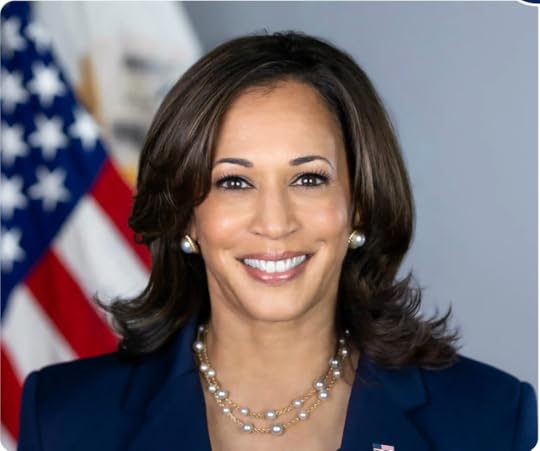
Following President Joe Biden's historic decision to suspend his candidacy for a second term in office, he and most of democratic delegates have thrown their support behind Vice President Kamala Harris for the highest office in the land. As "Trumpland" scrambles to respond to this sudden shifting of the state of play, one guaranteed card they will lay down is calling VP Harris a "DEI candidate" to attempt to minimize her legitimacy as well as dog whistle to the standard bearers of the party - Straight White Evangelical Men or (SWEM) that yet another example of the impending demographic watershed against their prominence (and societal dominance) is now the clear and present danger. In this article, we will analyze Vice President Harris's career and record as California State Attorney General, Senator, and Vice President and examine what it means to represent for all Americans as a loud and proud DEI candidate.
In the landscape of American politics, Vice President Kamala Harris stands as a beacon of diversity, equity, and inclusion (DEI). Her ascent to one of the highest offices in the land is not just a personal achievement; it symbolizes a shift towards a more inclusive and equitable society. However, this journey is fraught with challenges, especially from groups that seek to define DEI on their own terms, often distorting its true essence. To understand what it means to represent DEI authentically, we must delve into the contrasting visions presented by Kamala Harris and her detractors, particularly the Republican Party and Straight White Evangelical Men (SWEM).

Diversity, Equity, and Inclusion are not just buzzwords; they are principles that drive societal progress. Diversity speaks to the representation of various demographics, ensuring that different voices and perspectives are heard. Diversity leads to innovation and innovation to societal progress. Equity involves creating fair opportunities for all, acknowledging systemic barriers, and working to remove them. When equity is present everyone knows they have the power to fully participate in society - it's fundamentally about fairness. Inclusion is about fostering environments where everyone feels valued and empowered to contribute. Effective inclusion leads to engagement and productivity for everyone.
Kamala Harris embodies these principles through her policies, actions, and personal narrative. As the first female, Black, and South Asian Vice President, her very presence challenges the status quo and signals a broader acceptance of diverse identities in leadership. Her policy focus on criminal justice reform, healthcare equity, and economic empowerment further cements her commitment to these ideals.

The Republican Party and SWEMs often present a contrasting vision of DEI. For many in these groups, DEI is seen through a lens of resistance, perceived as a threat to traditional power structures. This perspective is evident in the pushback against affirmative action, voting rights expansion, and even the mere discussion of systemic racism.
For these groups, the fear is that DEI initiatives will undermine their position and privilege. They often frame DEI efforts as "reverse discrimination," suggesting that promoting diversity and equity somehow disadvantages straight white men. This narrative not only distorts the true intent of DEI but also stokes division and resentment.
The Republican Party's stance on DEI has often been one of obstruction and dilution. Their Project 2025 plan exemplifies this approach, outlining a vision that directly opposes many DEI initiatives:
Rollback of Affirmative Action: Project 2025 calls for the dismantling of affirmative action programs, arguing that they constitute unfair advantages for minorities at the expense of merit-based success. This position overlooks the systemic inequalities that affirmative action seeks to address and reinforces the status quo.
Voting Rights Restrictions: The plan includes measures to tighten voting regulations, which disproportionately affect minority communities. By advocating for stringent voter ID laws and reducing early voting options, Project 2025 aims to limit the political influence of these communities under the guise of preventing voter fraud.
Opposition to Critical Race Theory (CRT): Project 2025 strongly opposes the teaching of CRT and similar frameworks in schools. By labeling these educational approaches as divisive and un-American, the plan seeks to suppress discussions on systemic racism and historical injustices.
Reduction of Government Diversity Programs: The plan proposes significant cuts to federal diversity programs, including those aimed at increasing minority representation in government and business. This reduction would undermine efforts to create more inclusive workplaces and leadership structures.
Immigration Policy Reforms: Project 2025 advocates for stricter immigration controls and a reduction in pathways to citizenship for undocumented immigrants. These policies would disproportionately affect communities of color and hinder efforts to create a more inclusive society.
Economic Policies Favoring Deregulation: The plan promotes economic deregulation, which often benefits large corporations and the wealthy at the expense of working-class and minority communities. By reducing protections for workers and consumers, Project 2025 would exacerbate existing economic disparities.
The alignment of the Republican Party with SWEM further complicates its relationship with DEI. The SWEM demographic, which forms a significant part of the Republican base, is often resistant to changes that threaten their cultural and economic dominance. This resistance manifests in the promotion of policies and rhetoric that seek to preserve the status quo.
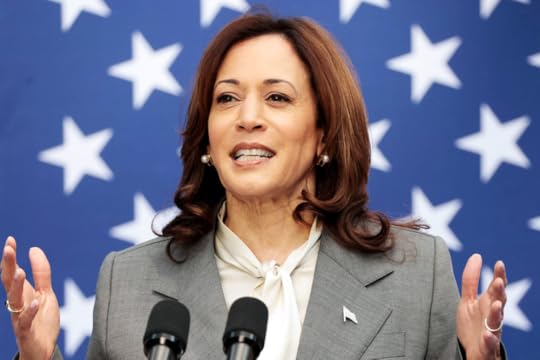
Kamala Harris's approach to DEI is rooted in her lived experience and a genuine commitment to systemic change. She understands that diversity goes beyond mere representation; it involves creating pathways for marginalized groups to thrive. Her advocacy for criminal justice reform, for instance, is not just about reducing incarceration rates; it's about addressing the racial disparities that pervade the system.
Harris's commitment to equity is evident in her policy initiatives aimed at leveling the playing field. From supporting small businesses in underserved communities to advocating for comprehensive immigration reform, her actions demonstrate a holistic understanding of equity. Inclusion, for Harris, means fostering a society where everyone, regardless of their background, has the opportunity to succeed.
VP Harris's public statements on DEI are unambiguous and provide insight into the leader she is today in her current capacity and will be even more of if given the opportunity to serve further by the American people. She has stated that "America's diversity is our promise, not our problem." Regarding equity she claims that "Equity means recognizing that everyone has not started out on the same footing. It’s about giving people the tools they need to compete on a fair and equal basis." She believes that "Inclusion is about creating a society where everyone is welcomed and valued, no matter who they are or where they come from."
She stands for a vision of America "where everyone, regardless of race, gender, or economic background, has the opportunity to thrive and succeed." But in order to achieve this bold vision "our nation was built by people who were willing to fight for equality and justice. We must continue that fight today and every day."

Kamala Harris's career is a testament to breaking barriers and shattering glass ceilings. Her journey is marked by a series of historic firsts and significant achievements:
First Woman District Attorney of San Francisco (2004): Kamala Harris became the first woman, the first African American, and the first South Asian to serve as San Francisco's District Attorney. Her tenure was marked by efforts to reform the criminal justice system and introduce initiatives aimed at reducing recidivism.
First Woman Attorney General of California (2010): Harris's election as Attorney General of California was another historic milestone, making her the first woman and the first person of African and South Asian descent to hold the office. During her tenure, she focused on issues such as combating human trafficking, defending marriage equality, and fighting for consumer protections.
First Indian American and Second African American Woman in the U.S. Senate (2016): Elected as a U.S. Senator from California, Harris continued to champion DEI principles on a national stage. She was a vocal advocate for healthcare reform, criminal justice reform, and immigration rights.
First Woman, Black, and South Asian Vice President of the United States (2021): Harris's election as Vice President represents the highest glass ceiling shattered in American politics. Her role signifies a new era of inclusive leadership and provides a powerful role model for future generations.
Each of these milestones is not just a personal achievement for Kamala Harris; they represent noteworthy progress for the country in embracing diversity. Her career trajectory challenges traditional norms and highlights the importance of representation in leadership. By breaking these barriers, Harris has paved the way for others to follow, inspiring countless individuals from marginalized communities to pursue their aspirations.
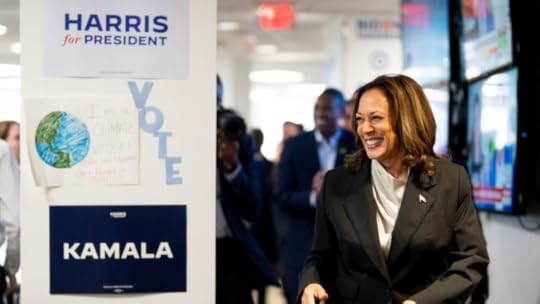
In a historic and unprecedented turn of events, Kamala Harris has already secured the majority of delegates to become the Democratic Party’s nominee for President of the United States in the 2024 election, set to face off against former President Donald Trump in a matter of months. As the Democratic nominee, Harris is positioned to further amplify her DEI vision on an even larger stage. Her candidacy is a testament to the progress the country has made in embracing diversity at the highest levels of government.
As Vice President in Joe Biden's administration, Kamala Harris has achieved several significant accomplishments that underscore her commitment to DEI and her readiness to lead the nation:
COVID-19 Response and Vaccination Campaign: Harris played a crucial role in promoting the nationwide COVID-19 vaccination campaign, particularly focusing on reaching underserved and minority communities to ensure equitable access to vaccines.
Infrastructure Investment and Jobs Act: She was instrumental in advocating for the Infrastructure Investment and Jobs Act, which aims to address racial and economic disparities by investing in public transit, clean water, and broadband internet access for all Americans.
Maternal Health: Harris has been a strong advocate for addressing the maternal health crisis, particularly among Black women. She spearheaded initiatives aimed at reducing maternal mortality rates and improving health outcomes for mothers and infants.
Voting Rights: Harris has been a vocal champion for voting rights, working to protect and expand access to the ballot box in the face of restrictive voting laws. She has led efforts to support federal legislation that would safeguard voting rights for all Americans.
Climate Change: Harris has supported the administration's climate agenda, focusing on the impacts of climate change on low-income and minority communities. She has emphasized the importance of a just transition to a green economy that benefits all Americans.
Immigration Reform: Harris has advocated for comprehensive immigration reform, including pathways to citizenship for undocumented immigrants and policies that reflect the nation's values of compassion and inclusivity.
Each of these achievements highlights Harris’s ability to address complex issues with a focus on equity and inclusion, reinforcing her vision for a more just and equitable America. Her candidacy challenges the conventional narratives and offers a powerful counterpoint to the often exclusionary and divisive rhetoric from her opposition.
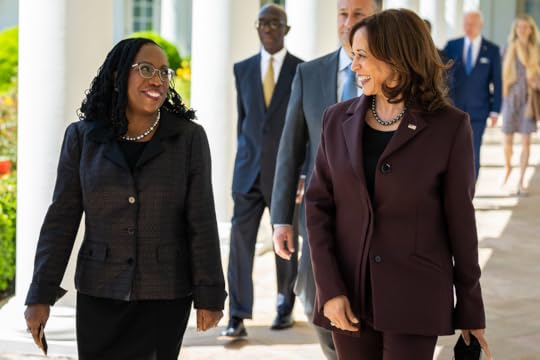
The battle for an inclusive and equitable society that embraces diversity in all forms is far from over. As Kamala Harris embarks on this new chapter, her commitment to these principles will be tested like never before. The Republican Party and SWEMs will continue to push back against efforts to create a more equitable and inclusive society. However, the progress made thus far offers hope.
Kamala Harris represents a new paradigm of leadership—one that is inclusive, equitable, and diverse. Her journey is a testament to the power of breaking barriers and challenging norms. As we move forward, it's crucial to support leaders who embody these principles and to remain vigilant against efforts to undermine them. The future of DEI in America depends on our collective commitment to these ideals and our willingness to stand up for what is right.
Kamala Harris's role as "the DEI pick" is not just symbolic; it is a call to action. It is a reminder that true leadership is about embracing diversity, championing equity, and fostering inclusion. It is about creating a society where everyone has a fair shot at success, regardless of their background. And it is about rejecting the narrow definitions of DEI imposed by those who seek to maintain the status quo. The journey ahead is challenging, but with leaders like Kamala Harris, the vision of a more inclusive and equitable America is within reach.
Omar L. Harris is the managing partner at Intent Consulting , a firm dedicated to improving employee experience and organizational performance and author of Leader Board: The DNA of High-Performance Teams; The Servant Leader's Manifesto; Be a J.E.D.I. Leader, Not a Boss: Leadership in the Era of Corporate Social Justice, Equity, Diversity, and Inclusion; Leading Change: The 4 Keys; Hire the Right W.H.O.M.: Sourcing the Right Team DNA Every Time; and The J.E.D.I. Leader's Playbook: The Insider's Guide to Eradicating Injustices, Eliminating Inequities, Expanding Diversity, and Enhancing Inclusion available for purchase in ebook, print, and audio on Amazon.com . Please follow him Instagram , Twitter , and/or his website for more information and engagement.
July 16, 2024
Trump and the Trust Equation

As a positive psychology and servant leadership stalwart - the ascension and permanence of Donald Trump's leadership brand has simultaneously baffled and alarmed me. But as a general student of leadership his magnetism intrigues me. What does it mean for his supporters, American society, and the world? In this article, I examine this subject through the lens of The Trust Equation developed by Charles H. Green, co-author of " The Trusted Advisor ," along with David H. Maister and Robert M. Galford. Their equation helps dissect the elements that constitute trust.

For leaders, trust is a non-negotiable currency.
The Trust Equation: Trust = (Credibility + Reliability + Intimacy) / Self-Orientation—provides a robust framework for evaluating how trust is built and sustained. Donald Trump’s political trajectory challenges this equation in profound ways. Despite glaring issues with credibility, reliability, and professional intimacy, and very high degree of self-orientation, Trump continues to galvanize a fervent base of supporters.
Let's explore this phenomenon through the lens of trust and leadership dynamics.
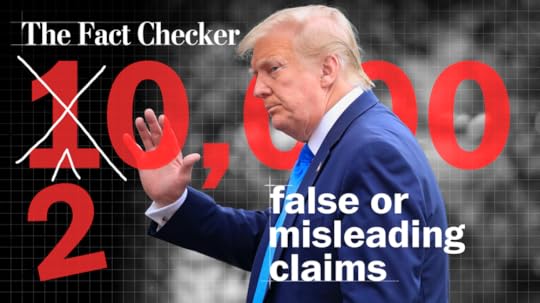
Credibility is the bedrock of trust. It hinges on truthfulness and expertise. It is usually measured by a leader's degree of competence, consistency, authenticity, respectfulness, and accountability. Donald Trump's political career, however, has been marred by a litany of false statements and debunked claims. From baseless assertions about election fraud to misinformation on the COVID-19 pandemic, Trump’s credibility has been repeatedly scrutinized and found wanting.
Yet, his supporters remain steadfast. They likely perceive these statements not as falsehoods, but as truths suppressed by a biased media and political establishment. For Trump’s base, credibility appears to be less about factual accuracy and more about a shared narrative that aligns with their worldview and values.
There also remains an element of subjectivity in what people deem as credible for a given position. Trump, while not the first U.S. president to achieve the position without previous political experience (Eisenhower, Grant, Taylor, Hoover, and Taft being the others), has managed to transfer credibility from being perceived as a successful business mogul into political capital. We will delve further into this question of transference later in this article.
Credibility can also be conferred by the perception of sameness as in someone appearing to reflect familiar values, beliefs, and behaviors as others. This is another area we must understand more fully as it relates to the question of White Christian male privilege in the fomenting of Trump's credibility with that base of constituents.

Reliability is consistency in actions and words. We can measure reliability by a leader's ability to manage commitments, proactively communicate, start and finish, and respect for time, theirs, and others. A political figure's reliability is usually measured by their ability to keep their campaign promises. Trump as a neophyte president in 2016 lacked the expertise and infrastructure necessary to enact many of his projected policies from the campaign trail - such as barely starting his border wall project (nor getting Mexico to pay for it).
Trump’s record also reveals numerous instances of contradictory statements and shifting positions. However, his supporters appear to view him as a reliable force against the status quo. His unpredictability, rather than a liability, is seen as a strategic asset that keeps his opponents off balance and his supporters invigorated. This unconventional reliability, grounded in a consistent challenge to the establishment, fortifies his base’s loyalty.
In a second term, based on the recent Supreme Court Ruling giving a President king-like stature plus a reading of the so-called Project 2025, voters in his base can expect a significant boost in Trump's reliability to deliver on what he is promising. And this increased reliability for an extremely dangerous agenda should be taken very seriously indeed.

Professional intimacy involves a sense of closeness and personal connection. When leaders can find common ground with others, keep things simple, make interactions enjoyable, be inspirational, and act with integrity, we are drawn to them. Each of these elements can also be considered highly subjective, especially when the leader in question possesses charisma and celebrity.
Trump’s brash, unfiltered communication style, especially on social media, creates an illusion of intimacy. He speaks directly to his supporters, bypassing traditional media filters, and resonates with their frustrations and aspirations. This direct engagement fosters a unique intimacy, even if it lacks the depth typically associated with this element of trust.
Shocking or not for a self-proclaimed billionaire with no record of caring about or supporting common folks before seeking political office, but Trump's supporters feel remarkably close to him as evident by the outcry after his New York conviction or even the recent attempted assassination. The phenomenon that may explain this is known as a parasocial relationship which is a one-sided connection with a celebrity or other public figure that someone doesn't know in real life. People can often develop feelings of affection, gratitude, longing, encouragement, and loyalty towards celebrities.

High self-orientation, the tendency to prioritize one’s own interests, usually erodes trust. Ego is the root cause driving high self-orientation. As a stand-alone issue, a person with a big ego might be annoying but harmless - unless the person in question is in a position of leadership and/or authority over others.
Those with overinflated senses of self are often referred to as narcissists. But this is not always the case. For the narcissist, their ego is their entire world, and they may resort to emotional abuse or manipulation to defend it. When a narcissist perceives a threat to their superior status or feels they are not receiving enough recognition, they may use negative reinforcement as a form of punishment. To restore their inflated self-image, a narcissist often needs to diminish others. This can involve devaluing others (Mexican rapists and African s%#thole countries), speaking condescendingly (she's not my type), giving backhanded compliments, or harshly judging others to elevate their own status (Sleepy Joe/Crooked Hillary).
Trump’s actions often appear self-serving, from business dealings to political maneuvers. Despite this, his supporters seem to interpret his self-orientation as a necessary trait for someone battling a corrupt system. They likely see his self-interest as aligned with their broader cause, allowing him to maintain their trust even as he demonstrates high self-orientation.
This phenomenon will be familiar to anyone who has read John C. Maxwell and his five levels of leadership. Based on this rubric, it would be hard to place Donald Trump above Level 2: Permission - where people follow because they choose to. To his followers, however, Trump seems to have cleared the pinnacle of level 5 leadership where others follow because of who a leader is and what they represent. In this case, a disruptive political outsider who represents the end of government as we know it.
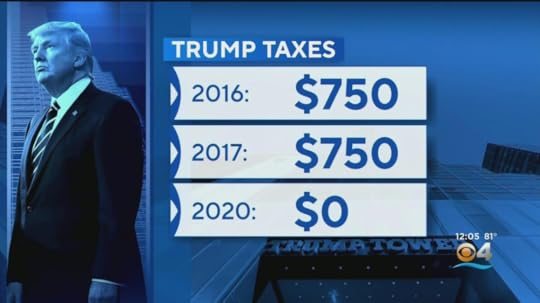
Another crucial factor in understanding Trump's appeal is the concept of transference. Trump has long been perceived as a successful businessman, billionaire, PR guru, and celebrity. These attributes have created a reservoir of trust among his supporters, who transfer their admiration of his perceived success in these areas to his political persona. This transference means that his followers see him as an effective leader capable of navigating complex situations and achieving success, reinforcing their trust in him despite the traditional trust equation indicators.

Trump’s approach is also not unique among authoritarian leaders. Figures like Vladimir Putin, Recep Tayyip Erdoğan, and Jair Bolsonaro exhibit similar dynamics. Putin sustains support through nationalism and media control, presenting himself as Russia's defender. Erdoğan emphasizes religious and nationalistic values, consolidating power by portraying himself as Turkey's protector. Bolsonaro leverages inflammatory rhetoric and social media to position himself as an anti-establishment figure. These leaders, like Trump, harness emotional and psychological drivers, such as fear and identity politics, to cement their support.

In an age demanding greater transparency, Trump and similar leaders present a paradox. Their supporters, who often call for transparency from traditional institutions, seem to accept and justify their leaders' opacity. This paradox is driven by selective perception, distrust of traditional institutions, and cognitive dissonance. Supporters may overlook the lack of transparency, believing their leader is fighting a greater battle aligned with their values, or dismiss calls for transparency as tactics from opponents.

A final but crucial aspect of Trump's support base is the demographic influence of white Christian male privilege. This privilege plays a significant role in shaping political allegiance and perception. For many of Trump’s supporters, his identity as a white, Christian male resonates deeply with their own, reinforcing a sense of shared identity and values. This demographic alignment amplifies his appeal and trustworthiness among his base, who may feel that their cultural and societal norms are being upheld and defended by Trump. This phenomenon underscores how demographic factors and identity politics intertwine with emotional and psychological drivers to sustain loyalty.
The perceived erosion of this privilege has led to the war on "wokeness", anti-feminism (abortion bans) and anti-DEI backlash, and significant pushback on gains in the LGBTQ+ community. This constituency clamors for a return to a moment where their reign over the power structures of the country and world was unchecked by so-called progressive movements manifesting more freedoms and positive outcomes for a more diverse society.
As Robin DiAngelo states in her book White Fragility:
I would extend this concept to other known isms like racism, sexism, ageism, ableism, classism, homophobia, transphobia, xenophobia, Islamophobia, colonialism, nationalism, colorism, heterosexism, ethnocentrism, and nativism. This is why we see a proposed second term agenda from Trump which aims at eliminating women's rights to choose, destroying the division of church and state, "deleting the terms sexual orientation and gender identity (“SOGI”), diversity, equity, and inclusion (“DEI”), gender, gender equality, gender equity, gender awareness, gender-sensitive, abortion, reproductive health, reproductive rights, and any other term used to deprive Americans of their First Amendment rights out of every federal rule, agency regulation, contract, grant, regulation, and piece of legislation that exists" (a direct quote from Mandate for Leadership - The project 2025 Primer), and "dismantling the administrative state" which provides the social safety net from Medicare and social security to immigrant protections to welfare and other public assistance efforts.
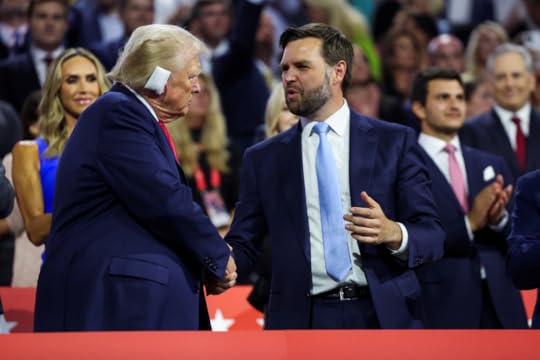
The continued support for Trump, despite deficiencies in the trust equation, highlights a complex interplay of emotional and psychological factors. For many supporters, Trump embodies their values, frustrations, and hopes. This deep emotional connection surpasses traditional measures of trust and loyalty, rooted in shared identity and emotional resonance.
Assessing whether trust gained through the trust equation is more real or sustainable than support derived from emotional and psychological drivers is intricate. Traditional trust, based on credibility, reliability, and intimacy, is generally more stable and enduring, built on consistent, measurable attributes. However, emotionally and psychologically driven support can be exceptionally powerful and resilient, often impervious to external criticism and factual challenges.
The sustainability of this support depends on the political and social context. In environments that continuously reinforce emotional and identity-based appeals, such support can endure. Conversely, in contexts where transparency, accountability, and factual integrity gain prominence, traditional trust may prove more enduring.
This raises a critical question:
The answer lies in the dynamic interplay of belief systems, identity, and the context within which trust is evaluated. For Trump’s supporters, trust is not solely built on traditional metrics but on a complex web of emotional, psychological, and identity-based factors that transcend conventional understanding.
Donald Trump’s ability to energize his supporters despite low credibility, reliability, and professional intimacy (as measured by the trust equation), and high self-orientation (based on direct observation), redefines conventional understandings of trust in leadership. His style highlights the critical role of emotional resonance and identity in sustaining support. As political landscapes evolve, Trump and other authoritarian leaders offer profound insights into the future dynamics of trust and leadership. The comparison between traditional trust and emotionally driven support underscores the multifaceted nature of political loyalty and its implications for sustainable leadership.
Understanding Trump's appeal is crucial to bridging the growing divide in this country. Name calling and hand wringing are poor strategies. Sun Tzu stated it best in the Art of War:
Neither Republicans nor Democrats are the enemy in this instance. Our enemies are weaponized ignorance, willful deceit, propagandized theatre, and power mongering by a few scared men worried to death that their tenuous grip on the authority of this great nation will finally slip beyond their grasp. We must see the enemy, recognize his tactics, and respond in kind. We deserve better than Donald Trump and in November we must prove this once again or face the consequences of a fundamentally untrustworthy leader possessed with terrible powers.
For more on this topic, check out my blog post: https://www.intentconsultants.co/post/why-do-we-expect-so-little-of-our-leaders
Omar L. Harris is the managing partner at Intent Consulting , a firm dedicated to improving employee experience and organizational performance and author of Leader Board: The DNA of High-Performance Teams; The Servant Leader's Manifesto; Be a J.E.D.I. Leader, Not a Boss: Leadership in the Era of Corporate Social Justice, Equity, Diversity, and Inclusion; Leading Change: The 4 Keys; Hire the Right W.H.O.M.: Sourcing the Right Team DNA Every Time; and The J.E.D.I. Leader's Playbook: The Insider's Guide to Eradicating Injustices, Eliminating Inequities, Expanding Diversity, and Enhancing Inclusion available for purchase in ebook, print, and audio on Amazon.com . Please follow him Instagram , Twitter , and/or his website for more information and engagement.
March 22, 2024
Debunking Gender Pay Gap Myths and Solving the Real Issues

As we progress through this #womenshistorymonth it is a good time to revisit progress against one of the persistent inequities in society - the #genderpaygap.
It may surprise some that there are several myths regarding this topic that need to be debunked to clarify the path forward to solving this complex issue. The rationale for closing this gap couldn't be more obvious - increasing economic growth and prosperity of the majority population (at least here in the US where women represent 50.5% of the people), reducing poverty, improving family well-being, and even enhancing corporate performance.
Myth #1: All women are paid only about 83% of what men are paid. Truth: That number is comparing the total amount of salary paid to men and to women in this country. It does not take into account such crucial factors as profession, qualifications, type of employer, seniority, hours worked or many other things that go into deciding compensation. When these basic factors are taken into account, the gender pay gap vastly decreases. Truth: There is an uncontrolled gender pay gap and a controlled gender pay gap. The uncontrolled gender pay gap serves as a mirror reflecting our collective valuation of women's contributions versus those of men within the workforce. This gap, often termed the "opportunity gap," lays bare the disparity in employment and opportunities allocated between genders, illuminating a skewed playing field. On the flip side, the controlled gender pay gap scrutinizes the principle of "equal pay for equal work"—it evaluates the compensation women receive relative to men when both hold identical or comparable roles, underpinned by similar qualifications. This differentiation is crucial; it not only highlights the existing inequities but also underscores the societal and organizational shifts necessary to achieve true parity in the workplace. When comparing two people in the same profession, with the same seniority, working the same number of hours, and so forth, women earn $0.98 for every dollar that a man earns. (https://www.payscale.com/research-and-insights/gender-pay-gap)Myth #2: The wage gap exists because women (and other ethnicities and identities choose lower-paying careers.) Truth: Women (and other ethnicities/identities) are more limited than men in terms of livelihood options due to bias and discrimination (especially in STEM fields such as science, technology, engineering, and mathematics). Truth: According to the 2024 Payscale Gender Pay Gap report, "the top 20 positions with the widest controlled gender pay gap include jobs in sales, jobs in religious organizations, jobs in finance, jobs in installation, maintenance, and repair, jobs in manufacturing, jobs in operations, and jobs in surgery. Holistically, these are jobs and industries subject to stronger gender norms, where it might be more challenging for women to find employment as well as compete for equal pay."Myth #3: All women face the same pay gap. Truth: The pay gap is nearly non-existent for young women but grows over time due to women’s choices about family. There’s almost no pay gap for single childless women, but the wage gap begins to increase around age 25, likely due to choices about family roles. Truth: The "motherhood penalty" refers to a systematic setback many women face in their careers and earnings following motherhood. This penalty manifests through reduced income, missed promotion opportunities, and often a diminished perception of professional commitment and capability. It's a stark illustration of how deeply embedded societal norms and workplace structures penalize women for embracing motherhood, subtly reinforcing the archaic notion that professional success and parenting are mutually exclusive for women.Addressable Issue #1: The Uncontrolled Pay GapIn 2024, the uncontrolled gender pay gap stands at $0.83, signifying that, on aggregate, women's roles yield earnings that are 17 percent lower than those of their male counterparts. This uncontrolled gap is equally significant as the controlled pay gap, laying bare the broader disparity in economic influence and wealth between genders, highlighting the gendered nature of power and financial accumulation. The eradication of the controlled pay gap, ensuring equal pay for men and women in identical roles with similar qualifications, does not diminish the importance of the uncontrolled gap. It continues to underscore a persistent issue: the access to higher-paying jobs remains unevenly distributed, with men enjoying a disproportionate advantage over women in reaching these lucrative positions. Solving this issue requires a multifaceted strategy including:
Leadership Commitment: Leaders at all levels must commit to closing the gender pay gap, recognizing it as both a moral imperative and a strategic advantage. This involves setting clear goals, measuring progress, and holding themselves accountable for achieving parity. Transparent Compensation Practices: Organizations should adopt transparent compensation practices, including regular audits of pay equity across genders and roles. Transparency helps identify disparities and builds trust among employees, demonstrating the organization's commitment to fairness. Career Development Programs: Implementing mentoring and sponsorship programs, especially for women and underrepresented groups, to support their career advancement. These programs can help overcome the barriers to accessing opportunities and navigating professional growth.Addressable Issue #2: Increasing Equity of Opportunity Regardless of RoleResearch and analysis of the gender pay gap shed light on the societal prejudice that men are inherently more fit for work and warrant higher compensation than women, even when performing identical roles. While aggregate data highlight this issue broadly, it becomes unlawful at the level of an individual organization if the differences in pay cannot be justly accounted for by the organization's compensation strategy. Therefore, addressing this issue requires a holistic and systemic approach to increasing equity of opportunity across all roles, focusing on creating an environment where everyone, regardless of gender, race, or background, has access to the same opportunities for growth and advancement. Some elements must consider:
Implement Bias-Free Recruitment and Promotion Processes: Use structured interviews, standardized evaluation criteria, and diverse hiring panels to minimize biases in recruitment and promotion decisions. This also includes transparently sharing criteria for advancement and ensuring that opportunities are communicated broadly to reach all potential candidates. Regular Equity Audits: Conduct regular audits of organizational practices, from hiring through promotion and beyond, to identify and address any disparities in opportunity. This should include reviewing how projects are assigned, who is considered for high-visibility tasks, and how contributions are recognized and rewarded. Enhance Employee Voice: Create platforms and forums where employees can share their experiences and suggestions for improving equity and inclusion. This could include regular surveys, town hall meetings, and feedback mechanisms that ensure all voices are heard and considered in decision-making processes.Addressable Issue #3: Eliminating the "motherhood penalty"The disparity in earnings between genders narrows when examining men and women without children, with the uncontrolled pay gap improving to $0.88 for every dollar, indicating that childless women encounter fewer societal obstacles in ascending the corporate hierarchy or landing high-stakes, well-compensated positions (notwithstanding the fact that mothers possess equal capability). Additionally, women may face a penalty based on the anticipation that they might eventually become mothers, even if they have no intention of having children, a phenomenon referred to as the "childbearing penalty."
Remarkably, when the gender pay gap analysis is adjusted for job characteristics, we find that there is equal pay. The incomes of women without children align with those of their male counterparts without children. This finding corroborates studies suggesting that the act of having a child, or the potential to have a child, is the primary or true driving factor behind the disparities in gender pay. Here are some ways to begin tackling this fundamentally unfair and antiquated "penalty":
Implement Comprehensive Parental Leave Policies: Nations like Sweden and Norway offer extensive parental leave policies that are gender-neutral, encouraging both parents to share childcare responsibilities. These policies help diminish the career interruptions that mothers typically face, reducing the long-term impact on their earnings and career progression. Promote Flexible Working Arrangements: Flexible work options, including part-time work, remote work, and flexible hours, can help parents balance their professional and family responsibilities. For example, the Netherlands has embraced part-time work arrangements across various industries, allowing mothers (and fathers) to remain in the workforce without sacrificing their career advancement. Support Access to Affordable Childcare: Affordable and accessible childcare is crucial for enabling mothers to return to work. Countries like Denmark and Finland invest heavily in public childcare systems, ensuring that parents do not have to choose between their careers and affordable childcare. This support is critical in mitigating the motherhood penalty. Address Gender Stereotypes and Cultural Norms: Challenging and changing societal norms that perpetuate gender stereotypes is essential. Iceland, ranked highly for gender equality, actively promotes gender equality education from a young age and supports campaigns that challenge traditional gender roles, helping to shift perceptions about motherhood and work. Create Pathways for Career Advancement: Ensuring that mothers have equal opportunities for career advancement is crucial. Mentorship and sponsorship programs, as well as leadership development initiatives specifically designed for women, can help. For instance, in Canada, various professional networks and organizations offer mentorship programs to support women in leadership, helping to counteract the career stagnation often experienced by mothers. Encourage Paternity Leave: Encouraging fathers to take paternity leave, as seen in Iceland, can help normalize the shared responsibility of childcare, reducing the stigma and professional barriers mothers face. It promotes a more balanced distribution of childcare responsibilities, challenging the assumption that caregiving is primarily a woman's duty.As we navigate the complexities of the gender pay gap, it's evident that misconceptions cloud our collective understanding and hinder progress. This gap isn't merely about pay disparities for identical roles but encompasses broader issues of access to opportunities and the devaluation of work traditionally done by women. The evidence dismantles the myth that the gap is a relic of the past, highlighting it as a current issue that stifles potential and equity. By adopting transparent compensation practices, fostering inclusive cultures, and supporting work-life balance, we can challenge the status quo and move toward closing this gap.
The journey toward equity requires collective action and a steadfast commitment to change. It's not only a matter of fairness but a pathway to unlocking human creativity and potential stifled under inequity. As we embrace the challenge, let us hold ourselves and our institutions accountable, weaving equity into our societal fabric. Addressing the pay gap head-on promises a brighter, more prosperous future for everyone. This endeavor uplifts not just individuals directly affected but elevates our society as a whole, making the pursuit of closing the equity pay gap a worthy and essential endeavor.
Learn more about the gender pay gap and solving all manner of justice, equity, diversity and inclusion issues in the Kirkus Starred The J.E.D.I. Leader's Playbook: The Insider's Guide to Eradicating Injustices, Eliminating Inequities, Expanding Diversity, and Enhancing Inclusion.

July 26, 2023
Leadership Lessons from Barbie

Please note: this article contains spoilers.
One could be forgiven for thinking that a movie about a doll created in 1959 might be a cynical cash grab by a greedy toy company (looking at you Hasbro). But an innovative take on the familiar fish out of water tale together with a compelling story directed by Greta Gerwig and written by Gerwig and Noah Baumbach combined with a brilliant marketing campaign has driven record box office sales. The world is pink and we are all living in it.
The synopsis of the film goes: A Barbie doll living in Barbieland is expelled from the world for not being perfect enough, too eccentric and not fitting the usual mold. She goes on an adventure in the real world and by the time she returns to Barbieland to save it, she has gained the realization that perfection comes on the inside, not the outside, and that the key to happiness is belief in oneself.
On one level, Barbie is about ultimate self-acceptance, but through the lens of leadership this movie is also very much about embracing the chaos of change to create progress as well as the power of choice. As Barbie creator Ruth Handler once said:
Barbie always represented the fact that a woman has choices.
With this thought in mind, allow me to present 5 key leadership lessons gleaned from this crucial film.
Beware the bubble: Stereotypical Barbie and her Barbie compatriots live in the bubble of Barbieland where every day is the same, everyone is happy and positive, and everything is perfect. This is a utopian society where women occupy all the spaces men mostly occupy in the "real world"; from all branches of government to home ownership and all primary occupations such as doctors, physicists, astronauts, and the like. Stereotypical Ken, however, is unhappy with his relationship with Barbie, there is a "Weird Barbie" ostracized for her different appearance to her face (and behind her back), a pregnant Barbie who is glossed over, and a perception that due to Barbie's influence - the real world mirrored Barbieland in all aspects. Leadership Lesson: As comfortable as it can feel to exist in a bubble of the comfortable status quo - leaders understand that comfort leads to stagnation. As the saying goes - when we are comfortable, we aren't learning. Not that we should seek constant disruption, but there is always work to do in any organization and the perception of perfection is rarely true. This is embodied in the principle of Productive Paranoia that the best leaders embrace - meaning that the errors you're able to glean lessons from are those you manage to endure. Leaders skilled at averting downturns and managing chaos inherently understand the volatility of circumstances, anticipating rapid and extreme shifts. They are perpetually engaged in questioning, "What if?" Through prior preparations, the accumulation of reserves, maintaining a safety buffer, limiting risk, and continually sharpening their skills in favorable and unfavorable conditions, these leaders deal with disturbances from a vantage point of resilience and adaptability. Change is inevitable (even for Barbie): Suddenly in the middle of a dance party, Barbie begins to contemplate death. This leads to a major disruption to her routine and culminates in her becoming flat-footed and gaining cellulite. She visits Weird Barbie who explains that she must sojourn to the Real World to find the person playing with her as this person's thoughts and feelings have opened a portal between Barbieland and the Real World. As she embarks on the journey, she learns that Ken has tagged along, with catastrophic consequences. Leadership Lesson: Before diving headlong into diagnosing a changing situation, adroit leaders seek to understand the context behind the change in terms of volatility, uncertainty, complexity, or ambiguity. Depending on the diagnosis of the context, the level of confidence needed to navigate the change, the correct construct for the change, and even the culture's ability to absorb the change might shift. Representation matters: In Barbieland, women of all shapes, sizes, ethnicities, and ability types are embraced, seen, and joyous in their lived experiences. In the Real World, the Mattel Senior Executive team is represented by an all-male cohort capitalizing on experiences and perspectives for which they lack understanding (this is the real-life Mattel Senior Executive Team - judge for yourself). They keep Barbie's founder, Ruth Handler in a non-descript kitchen on the seventeenth floor. Upon meeting them for the first time, Barbie enquires as to the whereabouts of the woman CEO of Mattel and receives a rude awakening that the company that conceived her is run by a bunch of clueless Kens. Leadership Lesson: In the modern world, representation matters. It matters to the employees who are crucial to the productivity of the organization. It matters to the customer groups who consume or use the organization's products, services, and solutions. It matters to the communities where these organizations call their homes. Innovation requires insight and insight is derived from embracing different perspectives, backgrounds, and lived experiences. Leaders who don't fight for greater representation in today's society are destined to spin in the undertow while their more progressive counterparts surf the big waves. Confront brutal facts: Barbie can't understand how women in the real world have not achieved as much progress as her Barbie compatriots in Barbieland. This comes to a head in a scene where she meets the teenage girl she believes has been playing with her in the Real World and this girl is extremely unkind to Barbie and her legacy which includes encouraging a materialistic lifestyle and possessing “unrealistic body proportions.” This exchange coupled with meeting the all-male executives of Mattel, running into her creator Ruth Handler, and returning to Barbieland only to find that the Kens have taken over by introducing the concept of the patriarchy into their society - causes her loses her way and she collapses from the weight of the situation. Leadership Lesson: The night is darkest right before dawn. Only by truly excavating the root cause of a given situation can a leader turn things around. This requires the fortitude to meet facts as they are with no spin and deal with realities no matter how difficult to swallow. Once a situation is diagnosed for what it truly is, the paths out of the mud become much more evident. Progress is more important than perfection: Barbie is shaken to her core by the dynamic shifts to her world and world view. But due to the intervention of her Real World friends, she and her compatriots are able to reset the status quo established at the beginning of the film - only to smash it again for the sake of true progress. All the characters recognize that until everyone in their societal microcosm achieves equal value no one possesses equal value. As for Barbie herself, she chooses to become human in order to explore more facets of herself than are available in Barbieland. Leadership Lesson: Societal change comes with myriad pressures to align with current norms and trends - but this can often come at the cost of significant organizational disruption. Senior leaders want everything to work and work well and so are often scared by the prospect of incremental progress versus full out transformation. But when faced with uncertainty and ambiguity - iterative, incremental progress is more favorable than remaining stuck in an outdated and outmoded structure. The best leaders can embrace these challenging contextual factors and forge ahead.I really loved this movie. It was surprisingly deep, relevant, and impactful. The blend of humor, drama, and compelling characters really sucked me in. I give it 5 out of 5 stars.
What other leadership lessons did you glean from the film? Let us know in the comments below. And please give the article a thumbs up if you enjoyed and got anything out of it.
I have a new book out! Leading Change: The 4 Keys - Context, Confidence, Construction, and Culture.

In today's rapidly evolving global landscape, the ability to navigate and lead change is not just beneficial—it's essential. This capacity becomes even more critical for those in leadership positions, who must grapple with multifaceted challenges that demand innovative solutions.
In "Leading Change: The 4 Keys - Context, Confidence, Construction, and Culture," you'll embark on an insightful journey to discover the keys to effective change management. Crafted with thoughtful precision and backed by rigorous research, this illuminating book is more than just a guide—it's a manual for reshaping the future of organizations and society at large.
Bestselling, award-winning leadership author, consultant, and thought-leader, Omar L. Harris illuminates the importance of context in change, focusing on how understanding the broader environment can guide more effective decision-making. The role of confidence is explored in-depth, illustrating how this often-underestimated trait is vital for inspiring and motivating those facing change. With practical examples, the book underscores how constructing a detailed and thorough change plan is as crucial as its implementation. Finally, the significance of culture is examined, providing readers with the knowledge and tools to shape an adaptive and resilient organizational culture that embraces change rather than resisting it.
"Leading Change: The 4 Keys - Context, Confidence, Construction, and Culture" is a transformative read that challenges established paradigms and offers new lenses to view and manage change. Drawing from real-world case studies and the author's extensive experience, it presents a comprehensive framework for leading change that is both practical and profound.
Whether you're a seasoned leader, an aspiring manager, or simply someone interested in understanding the mechanics of change, this book is a valuable addition to your collection. Immerse yourself in its pages to master the art of leading change and inspire others to do the same.
July 25, 2023
Leadership Lessons from Oppenheimer

Please note: this article contains spoilers.
Whenever Director Christopher Nolan announces a new project, the world awaits expectantly for his latest creation to become available to the public. After the mixed results of Tenet (2020), Nolan turned his attention to a period epic based on the book American Prometheus: The Tragedy and Triumph of J. Robert Oppenheimer by Kai Bird and Martin Sherwin. Those who know a bit about the story of the crucial and enigmatic historical figure immediately met the announcement with excitement, eager to see how the auteur would treat the subject of his first biopic.
The synopsis of the new film goes: During World War II, Lt. Gen. Leslie Groves Jr. appoints physicist J. Robert Oppenheimer to work on the top-secret Manhattan Project. Oppenheimer and a team of scientists spend years developing and designing the atomic bomb. Their work comes to fruition on July 16, 1945, as they witness the world's first nuclear explosion, forever changing the course of history.
On one level, this film is about the inner workings of a person destined to change the course of human history, but it is also very much about owning the consequences of our actions as leaders. As Oppenheimer himself once said,
...Secrecy strikes at the very root of what science is, and what it is for. It is not possible to be a scientist unless you believe that it is good to learn. It is not good to be a scientist, and it is not possible, unless you think that it is of the highest value to share your knowledge, to share it with anyone who is interested. It is not possible to be a scientist unless you believe that the knowledge of the world, and the power which this gives, is a thing which is of intrinsic value to humanity, and that you are using it to help in the spread of knowledge, and are willing to take the consequences.
With this thought in mind, allow me to present 5 key leadership lessons from this incredible movie.
Follow your passions: During his early years as a physics student in The UK and later in Germany, Oppenheimer is haunted by visions of particle explosions and their energetic releases. With a singular talent for cutting through the noise to identify the core of many concepts as well as a Nikola Teslaian capacity for learning and mastering various disciplines; he made the leaps from Einstein's theory of relativity to build the practical theories of atomic release. His passions also led him to support controversial causes at the time but did not hinder his overall effectiveness at stewarding the Manhattan Project. Leadership Lesson: The most successful leaders are those who arrive at the position by way of a near vocational desire to serve and support the advancement of the field of leadership and management. When you hear that call to explore creating positive impacts on the lives of others, it is important to heed it. Weigh the implications of inaction: When Oppenheimer is approached by General Leslie Groves regarding the Manhattan project - Oppenheimer correctly surmises that the Nazis are 18 months ahead in their development of an atomic weapon. He understands instantly the implication of sitting on the sidelines and although he has some misgivings, decides on a partnership with the US Government that will change the world. Leadership Lesson: One thing effective leaders do well is contemplate the risk of doing nothing in the face of inevitable change. The most skillful leaders can then use these consequences to create the burning platform that gets others moving forward. Build a high-performance team: Due to his esteem in the field, Oppenheimer assembles a dream team of theoretical and practical physicists with the requisite temperament, talent, and discipline to do what no one had ever done. He effectively managed challenging egos and agendas during the storming phase to coalesce the group around a challenging yet achievable plan. He then provided direction, autonomy, support, motivation, and metrics to keep the team on track towards their goals. Leadership Lesson: In today's hybrid working world, leaders with the ability to get a group of people aligned on a goal bigger than themselves and then shepherd them toward achievement is one of the most crucial skills to possess. These leaders understand that they will confront Tuckman's stages of forming, storming, norming, and performing and systematically conquer each stage until the job is done. Transform theory into reality: Over and over in the film the characters discuss the limitations of theory on predicting what will happen in reality. Oppenheimer understands this is an area of weakness for him and ensures he has enough practical talent on hand to truly convert all the formulas and careful calculations into a tangible atomic weapon with predictable limits. Even so, the trinity test where the first bomb is exploded in Los Alamos is a horrifying revelation of how palpable things can get when they leap from the imagination into the real world. Leadership Lesson: Innovation doesn't just happen overnight. The best leaders leverage the process of empirical creativity to test and scale their best ideas. Empirical meaning - proven before overinvesting in a particular direction. This is a far more effective approach than using one's gut and instincts to make certain leaps. Often what we experience as some sort of power to invent the future is merely a result of careful study of current trends and the ability to embrace paradoxes to make things happen. Accept the consequences of success. Another ongoing concern for the minds behind atomic warfare was the possibility that the energy ignited by the trinity test might create a chain reaction that set Earth's atmosphere ablaze and thus ending humanity. Theoretically, this risk was calculated at near zero, but in later years, Oppenheimer reflected that they had incorrectly estimated the risk of the end of humanity due to nuclear war. It would be a danger as long as even one nuclear warhead remained armed in the world. Leadership Lesson: Most leaders are adept at course correcting when plans fail, but what about when plans succeed better than was imagined? Are you ready to accept the surge of responsibility that comes with sudden success? This is something that needs to be added to the calculus when initiating plans.Overall, Oppenheimer is a heady drama about a person and event that has ramifications to this day. Christopher Nolan has once again proven to be a master of cinema and has redeemed himself after the confusion of Tenet. (4.5 out of 5 stars from me).
Get my new book! Learn to crack the code to leading almost any organizational change and become a change master!

In today's rapidly evolving global landscape, the ability to navigate and lead change is not just beneficial—it's essential. This capacity becomes even more critical for those in leadership positions, who must grapple with multifaceted challenges that demand innovative solutions.
In "Leading Change: The 4 Keys - Context, Confidence, Construction, and Culture," you'll embark on an insightful journey to discover the keys to effective change management. Crafted with thoughtful precision and backed by rigorous research, this illuminating book is more than just a guide—it's a manual for reshaping the future of organizations and society at large.
Bestselling, award-winning leadership author, consultant, and thought-leader, Omar L. Harris illuminates the importance of context in change, focusing on how understanding the broader environment can guide more effective decision-making. The role of confidence is explored in-depth, illustrating how this often-underestimated trait is vital for inspiring and motivating those facing change. With practical examples, the book underscores how constructing a detailed and thorough change plan is as crucial as its implementation. Finally, the significance of culture is examined, providing readers with the knowledge and tools to shape an adaptive and resilient organizational culture that embraces change rather than resisting it.
"Leading Change: The 4 Keys - Context, Confidence, Construction, and Culture" is a transformative read that challenges established paradigms and offers new lenses to view and manage change. Drawing from real-world case studies and the author's extensive experience, it presents a comprehensive framework for leading change that is both practical and profound.
Whether you're a seasoned leader, an aspiring manager, or simply someone interested in understanding the mechanics of change, this book is a valuable addition to your collection. Immerse yourself in its pages to master the art of leading change and inspire others to do the same.



